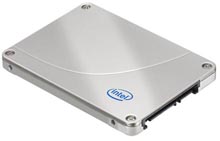Intel's 34nm SSDs: Probably just fast enough

All around Australia, computer hardware enthusiasts are simultaneously asking themselves the same question: "Is it time to replace my main hard disk with a solid state drive (SSD) alternative?".

(Credit: Intel)
The answer, after several days of playing with a 160GB review model of Intel's new and relatively inexpensive 34nm X25-M SSD drive, is a foggy "probably".
We'll post a more formal review with some proper benchmarks later, but in the short term I wanted to give readers a flavour for what kind of difference you can expect from Intel's new line of SSD drives, with specific reference to using them as a main system disk replacement for your desktop PC.
There is one reason we're paying so much attention to this particular line-up of SSD drives. Of course, several reviewers have noted that Intel is currently out in front of the rest of the pack when it comes to SSD performance and reliability (no big surprise here, it's Intel, after all). But more importantly, in late July Intel revealed its new batch of 80GB and 160GB X25-M SSD drives would receive a price cut of up to 60 per cent.
As we've previously pointed out, such a cut would be likely to place the 80GB model under AU$300, arguably pushing top-end SSD technology into a mainstream price range for the first time (Aus PC-Market currently has the old version of the 80GB drive for upwards of $600, a price few would be willing to pay).
This week we installed Windows 7 RTM and Ubuntu Linux 9.04 on a 160GB Intel 34nm X25-M drive, connected to a Dell Optiplex 960 desktop. This is a business machine with a 2.66GHz Intel Core 2 Quad CPU with 2GB of 800MHz DDR2 RAM. The machine's normal system drive is a 7200rpm, 160GB Western Digital drive (a traditional magnetic hard disk, of course). We found two things in general use with relation to the sample unit Intel lent us.
Firstly, installing any software to the SSD took quite a bit longer than it would when using a normal hard disk. Used to Ubuntu installs that only take a few minutes? Say goodbye to your afternoon. Installing Windows 7 and Ubuntu on the SSD took way more time than we're used to (although we didn't time it precisely; this blog is all about first impressions).
Strangely, installing applications such as the technical beta of Office 2010 or Photoshop CS3 wasn't too bad compared to the operating system installs. But if you are constantly installing, deleting and reinstalling software, we'd find it hard to recommend that you use an SSD for your main drive. It will slow you down.
This phenomenon also extended itself to copying files. Again, without formal tests, writing of any kind to the SSD just felt a lot more sluggish than with our normal hard disk. It was slow enough that we'd recommend you don't copy large files to your desktop if you do decide to use an SSD as your main system disk. Keep those bulky files on a separate magnetic disk (they're cheap and massive these days).
However, where the SSD caught up was in launching any form of application.
Launching Windows 7 and Ubuntu 9.04 took just a couple of seconds after the BIOS had finished its usual slow plodding work, and the same for shutting them down. Normally "heavy" applications such as Photoshop, Outlook and on the Linux side, GIMP and OpenOffice.org, opened almost instantly from the SSD; almost like opening a normal desktop file window.
And the time to read any document in general from the SSD disk was almost negligible. We ran the Linux command "du -sh *" from the root or / directory in Ubuntu. Unbelievably, this command, which checks the size of every file on the PC, returned a complete result almost instantly. Normally, depending on how many files you have and the speed of your hard disk, it can take tens of seconds.
There are other advantages to running an SSD drive as your main system disk. We didn't detect any heat or noise at all from Intel's offering, and it's probably less than a quarter of the size and probably less than that of the weight of a normal 3.5-inch magnetic optical SATA drive.
Overall, our unscientific experience of using one of Intel's inexpensive new SSD drives in a real-world environment is that they do have the potential to significantly speed up your PC; as long as you are prepared to use a traditional hard drive as a secondary file storage drive (which many people already do) and understand the speed limitations of writing to the drive and installing applications.